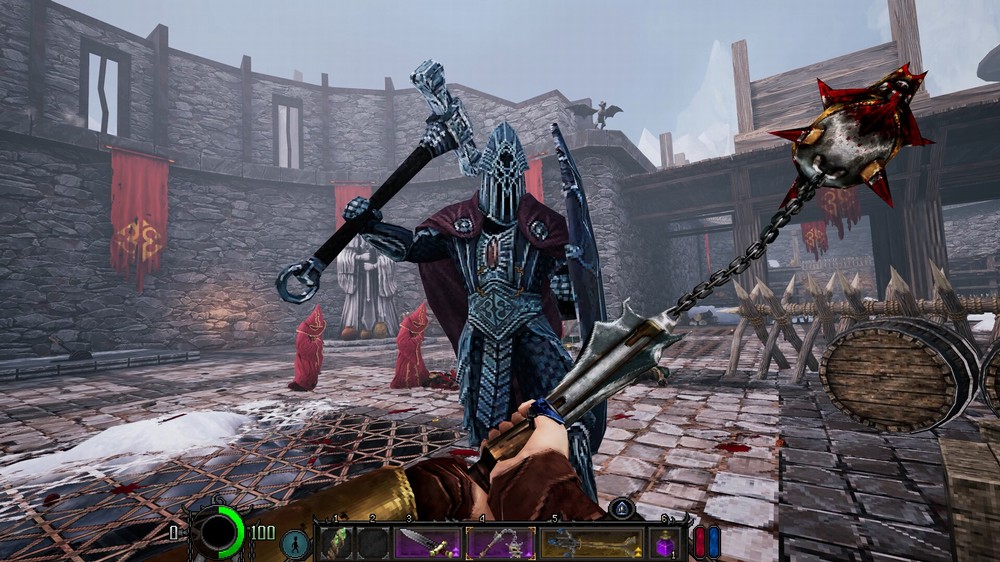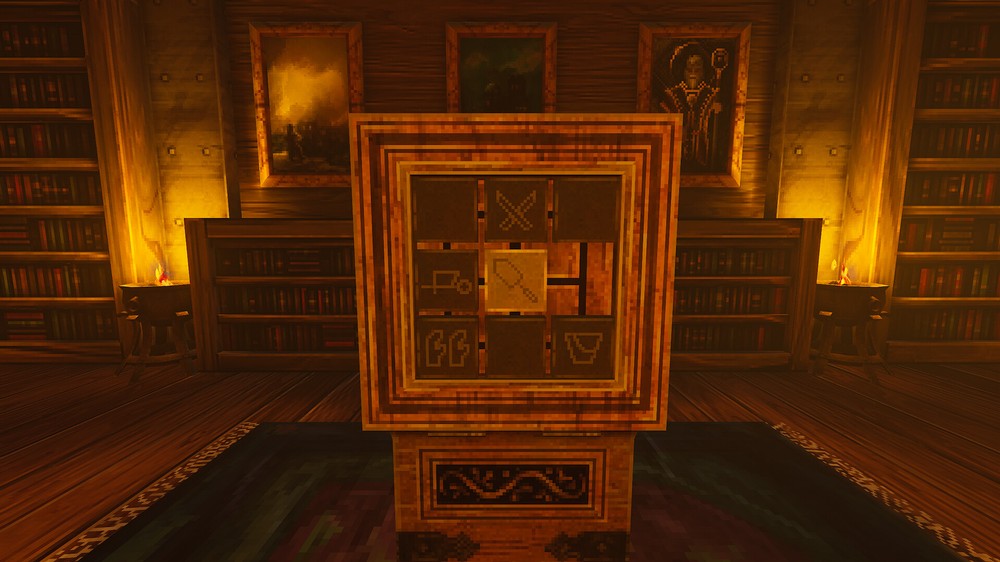As the ominous ferryman delivered me to a corpse-littered shore, he didn’t accept payment and just said, “You’ll be needing that more than me.” Graven’s bleak, plague-ridden atmosphere, sets up this retro-styled first-person puzzle-solving shooter that looks like it stepped out of the original PlayStation. Wearing its inspiration on its sleeve with predecessors like Duke Nukem, Wolfenstein, and Quake, this new setting is a little more subdued and ominous rather than loud and chaotic. It’s a quick hook to get you interested in exploring the grim and dark medieval fantasy world.
You play as a disgraced priest who after dying finds himself ferried to a plague-ridden world. Otherworldly forces have infected every corner of this sprawling town the central hub is a city called Cruxfirth. A once ambitiously large and flourishing people are now reduced to a small city block. While some shopkeepers, soldiers, and civilians remain in this depressed square, you’ll be venturing out on quests through its interconnected corridors and circle back to level up gear, turn in quests, and venture back out again. Your aim is to defeat a big bad, clear out sections of the city from infection, and uncover the mysteries as to how this city was overrun.
Mechanically, this is a shooter. You have a variety of weapons at your disposal from a shotgun-like crossbow, a classic sword, and a pistol-like wrist-bow. Aside from the physical weaponry, there’s a variety of magic books that grant abilities like fire and electricity that can be used to solve puzzles as well as in combat. Each weapon feels reasonably unique, with some feeling better to use than others. My favorite was a staff that when equipped with a stone modifier would amplify my physical attacks to propel enemies in the direction I had swung. It felt so satisfying running up to an enemy and blasting them into a nearby wall to explode in a cloud of guts and crumple the wall behind them. There is an arbitrary number of equipment slots at the bottom of your screen with larger pieces taking up multiple slots in your inventory and smaller items like health potions taking up less. I say arbitrary because when you go into your inventory it pauses the game and enemies. So, there is no penalty for keeping things like potions in your bag and pausing to quickly swap them in and out. It’s not too much of a gripe but it feels like half of a good idea.
Artistically, I love Graven, it was so reminiscent of the now retro-style early 3D games. Blood splatter with large and chunky pixels and floor tiling in big blocky stone textures warms my heart. I loved seeing all the new enemy types and how they were realized with this retro aesthetic in mind. Alongside these old-school visuals are a great number of sound effects and score. It goes a long way to tying the game’s aesthetic together and creating a unified haunting world.
Unfortunately, some of the design decisions undercut this mechanically sound package. Firstly, the save states and checkpoint systems wrestle with each other. With crows who fly off of posts at each checkpoint, it’s clear the game has a save state it can return you to, should you die, however upon each manual save and exit from the game, you’ll be brought back to the city center in Cruxfirth. Since the locations and biomes are all tied together from this center point, it wouldn’t be so much of a stumbling stone, if the game gave you a compass or a map. However, both are absent. For that reason, you spend an enormous amount of time chasing your tale, backtracking, and trying incorrect paths. It’s frustrating and undercuts the quick momentum you get from the early hours of combat and exploration.
For that reason, I stuck to longer play sessions or left my computer running, because I knew I didn’t want to retrace my steps. Traditionally at one end of the spectrum you have the coin gobbling arcade-style games that require you to make runs and see how far you get. On the other end, you have games that allow you to save your progress and even update you as to what you were doing when you logged off. Graven struggles to find a lane in either of these designs relying instead on the player to figure it out on their own. For this reason, the longer I spent with the game the more frustrating it became. It isn’t a dealbreaker by any means but be aware that the game rewards longer play sessions and will require you to dig through your quest journal regularly.
There’s a lot to like about Graven. The combat is solid, there’s a wonderful variety of locations and enemy types, the lore is deep and thoughtful, and aesthetically it’s a home run. However, some design decisions leave me scratching my head and undercutting the flow and rhythm. I would love to see if the developers update Graven and add in some quality-of-life features. They’ve already had three updates since launch so. If you are well aware of these shortcomings and want to get lost in a medieval doom world, Graven has a story it wants you to bash, shoot, and burn your way through.














